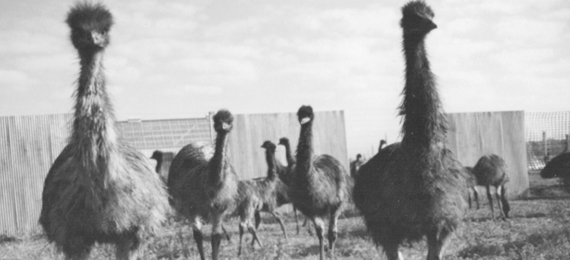
The Emu War or the Great Emu War was a wildlife management military operation held in Australia in late 1932. It occurred to support the public over the number of emus that were furiously running in the Campion district of Western Australia and destroying farmers’ land. The Australians named the activity “Emu War” and appointed armed soldiers with Lewis guns, but it turned into unsuccessful attempts to control the population of emus.
Great Australian Emu War of 1932
During the war, many birds were killed but the emu population did not reduce and they continued their crop destruction
Western Australian farmers had been experiencing tough times with their crops after the Great Depression. The difficulty time had increased because of the arrival of around 20,000 emus which migrated into the land during their breeding period.
1.When did Australia suffer from the Great Depression?
- A. 1920
- B. 1900
- C. 1929
- D. 1901
The framers went to request the government and also wanted to use machine guns to fight off the emus.
Sir George Pearce was Australia’s Minister of Defence who was highly concerned about Australian veteran farmers. The rules of battle were all set for the upcoming war and Australian troops would handle the weapons. The accommodation and food were provided by Australian farmers.
George Pearce supported the war by believing that emus would give some good target practice for the Australian soldiers.
This was also supported and encouraged by the Australian parliament hoping that it would be a better chance of showing that they supported the poor farmers.
The emu war was conducted under the command of Major G. P. W. Meredith of the Seventh Heavy Battery of the Royal Australian Artillery, along with Meredith soldiers including Sergeant S. McMurray and Gunner J. O’Halloran, who had two Lewis guns and 10,000 rounds of ammunition.
First Attempt of the War
In November, soldiers went to Campion where they found 50 emus. But the emus were out of range to shoot with guns/ weapons. Hence the local settlers tried to ambush them but the emus split into small groups and escaped from them because emus were difficult to target when split into small groups. Later, a small flock was killed and a dozen emus were killed.
Second Attempt of the War
After quitting the military war, the emu again began to destroy the crop regularly. Farmers again requested help. James Mitchell, the Premier of Western Australia supported the farmers and arranged military assistance. In this operation, around 300 emus were killed at the beginning.
Till 13 November 1932, soldiers found immense victory on the first 2 days and killed around 40 emus. On the third day, November 15, did not succeed as they expected. Later, on December 2, soldiers killed almost 100 emus per week. Meredith claimed on 10 December that 986 kills with 9,860 rounds. He also added that around 2,500 injured emus died.
On 23 August 1935, the article in the Coolgardie Miner stated that machine guns “criticized in many quarters, the method proved effective and saved what remained of the wheat.”
After these attempts farmers did not stop requesting help, they asked for military assistance in1934, 1943, and 1948, then the Government turned down the request.
After the investigation, the result claimed that 57,034 emus were killed in six months in 1934.